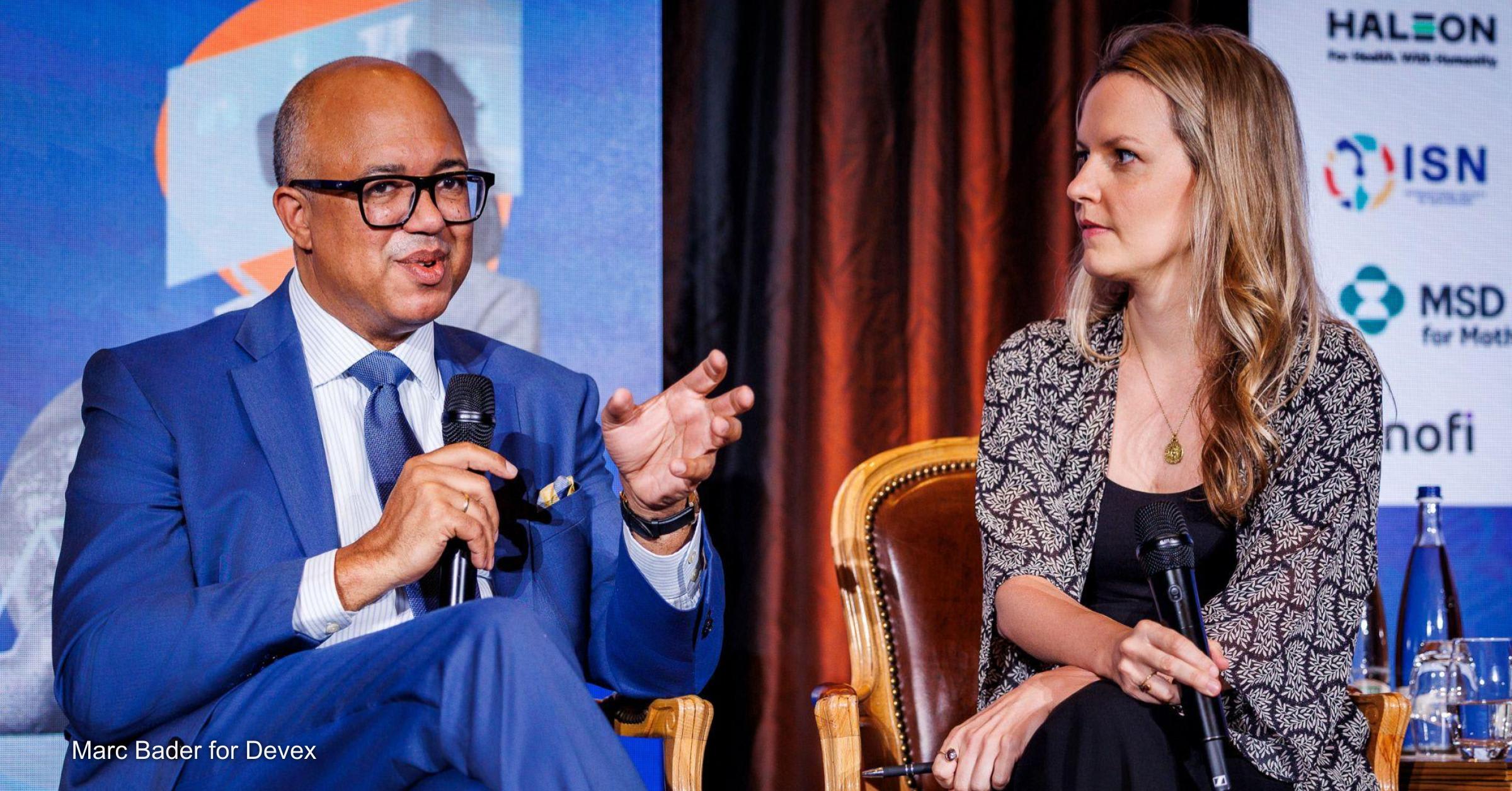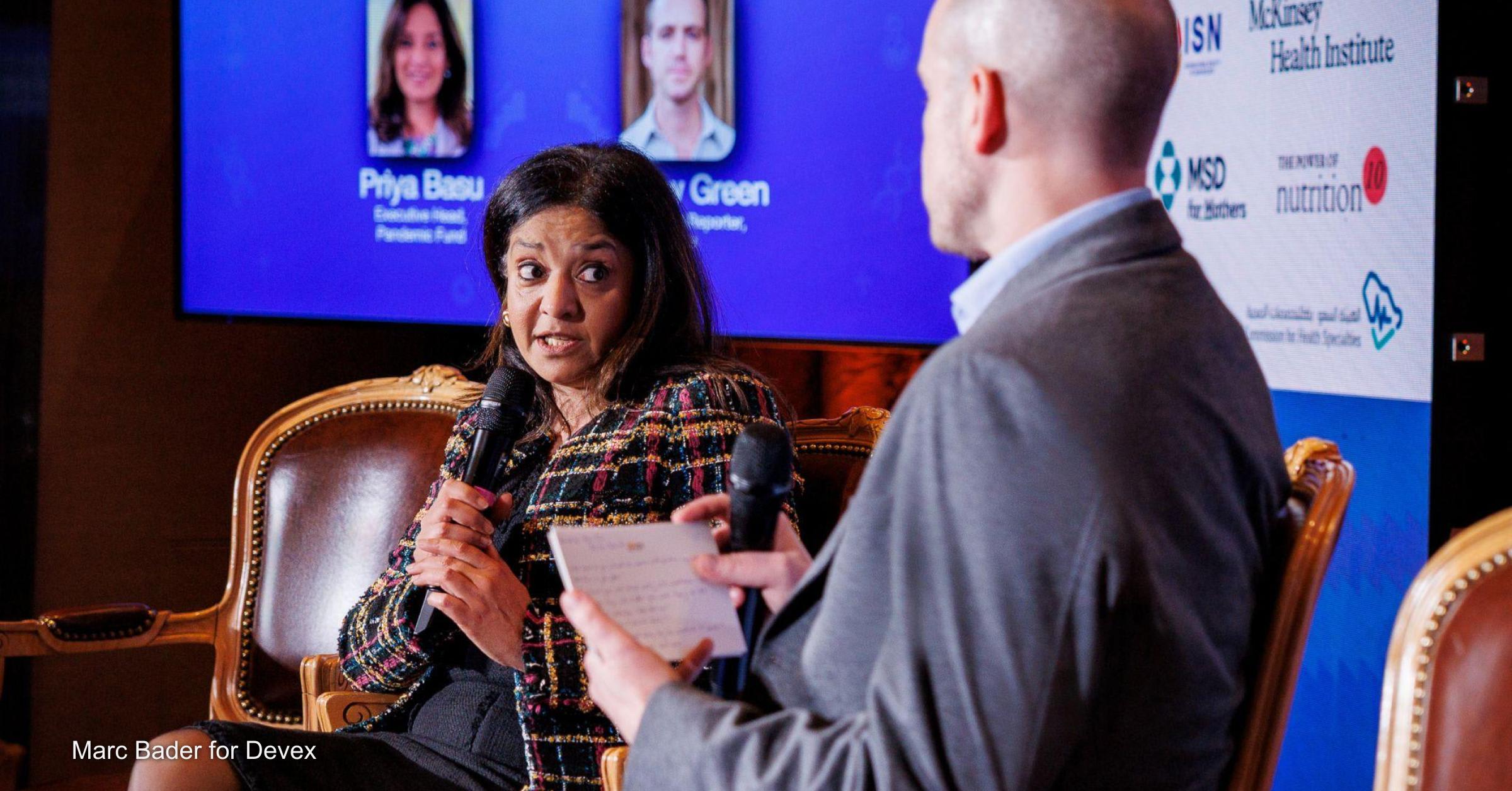WHO leaders on epidemic preparedness, organization diversity, sustainable funding
Participants at the 2019 Global Health Security conference discuss the challenges facing WHO around workforce issues and sustainable funding needs in global health emergency response.
SYDNEY — Last week, the Global Health Security 2019 conference in Sydney, Australia, brought together leading experts working in health security to facilitate greater engagement between the diverse sectors contributing to action. On June 19, Devex hosted a conversation with three World Health Organization leaders to discuss the challenges facing the institution and its member countries in responding to global health emergencies — including workforce, funding needs, and balancing the diversity of their organization’s structure. Dr. Poonam Singh, WHO regional director for Southeast Asia, Dr. Takeshi Kasai, WHO regional director for the Western Pacific, and Dr. Jaouad Mahjour, assistant director-general of the emergency preparedness and international health regulations department, shared their insights to help enable better action in the space of global health response and preparedness. Preparing the workforce In May, the Independent Expert Oversight Committee for the WHO Health Emergencies Programme observed that after the end of the outbreak of Ebola in Equateur province of the Democratic Republic of the Congo in July 2018, most of the program staff were redirected to fill leadership positions in North Kivu. With the quick redeployment of staff, the committee was concerned about staff exhaustion, as well as shortages of staff with the necessary skills to manage emergencies. The review was in response to a request to review corporate cultural issues that could impact the performance of the Health Emergencies Programme. It was a challenge Mahjour said WHO recognized — but were challenged with the need to ensure health care workers assisting responses spoke the local language and understood practices, currently limiting the capacity. But he said it highlighted the need to be focusing on building capacity within countries as part of preparedness. For the regional directors, the Ebola challenges did make them think about their own capacities. Singh explained that in 2014, the Southeast Asia region established benchmarks for country preparedness and reviewed those benchmarks to identify training needed for any regional health challenges. The basic capacities were good, she said, saying that the strong immunization system built to respond to the Rohingya crisis had so far seen no outbreaks for example. But despite this, they understood the challenges they faced — from natural disasters to outbreaks. “We’ve had everything from A to Z and we have at least one outbreak every week. So we now have to be prepared.” Countries are the first to respond and need to have the capacity to respond, Singh said. And their programs aim to build that capacity including at all levels of government and within communities — which requires continuous development and improvement. Kasai explained that the Western Pacific region began trials in 2015 with Ebola to send a team from the Western Pacific — to help build capacity in their region. “We need to continue to improve, and to do that, we need to try to send new staff to gain experience,” Kasai said. “We want them to have the experience, but we need to protect them and maintain safety and security.” Forward-thinking For WHO, the risks of health emergencies such as Ebola need to be juggled with other health challenges. In Kasai’s recent engagement with members of the Western Pacific region, he found a range of health risks that needed a response. “We don’t need funding for preparedness, we need sustainable funding for preparedness.” --— Dr. Jaouad Mahjour, assistant director-general of the emergency preparedness and IHR department “Our region is diverse,” he explained. “There are specific issues some countries face — for example in the Philippines, 1 in 100 people have active TB. This is an emergency which we have to respond to. We also have drug-resistant malaria which Cambodia, Vietnam, and Laos want to collectively address.” Concerns across the region include health security, antimicrobial resistance, noncommunicable diseases, ageing, and, particularly, climate change. “When we walk around the Pacific, this is what we hear,” Kasai said. But there are challenges that are immediate and others emerging — and planning for the coming health risks are equally important for WHO. “We engaged health ministers, heads of government, foreign ministers, public health experts, and civil society to get a broad perspective of what they perceive as the major challenges and challenges which could happen in the future,” Singh explained. Seven challenges emerged with NCDs identified as a priority challenge of the future which all member states in the Southeast Asia region. AMR was identified early as a priority and resulted in a ministerial declaration for action. All countries in the region have national action plans — with some countries able to mobilize resources but others are struggling. The challenges in looking at the risk factors, Singh said, was determining what were the “best buys.” There were limited resources with the Southeast Asia region with 40% of the world’s poor, and no major donors in the region. For Mahjour, preparedness is the critical element for future threats. Better surveillance, he said, would help improve responses to all future risks and sustainable funding is key. “We need sustainable funding,” he said. “We don’t need funding for preparedness, we need sustainable funding for preparedness, and we need also to bring all sectors to this discussion.” Without preparing the community he added, WHO could not respond to threats — current and emerging. Focusing funding With the question of sustainable funding comes the need to be strongly focused on the implementation of national action plans for health security. “When we ask countries to prepare a plan, we also have a moral obligation to help them to implement those plans,” Singh said. “And that is where we fail.” For Mahjour, this is critical, as otherwise issues identified in joint external evaluations can be repeated in subsequent reviews. “The most urgent thing to do is to help countries implement their national action plans,” Mahjour said. “As of today, not one is funded to be implemented. Yes, countries should mobilize domestic resources, but we know that in low-income countries, preparedness will not be a top priority. It is not a big amount, but we need the funding to support this process.” Technical assistance, he said, is also important to help countries utilize this funding in a way that would support them sustainably. Improving representation Bringing low- and middle-income nations to the table to be involved in policy and strategy is critical to support the necessary political buy-in and capacity building. But there was a risk, Singh said, of countries being left behind. “Diversity is the key for our organization to make the right decisions.” --— Dr. Takeshi Kasai, WHO regional director for the Western Pacific “In developing policy and strategy, often we find that developing countries are not there,” Singh said. “We try to sponsor countries to participate in forums to help with this, and allow them to take ownership of policy-making decisions.” The Independent Oversight and Advisory Committee of the WHO Health Emergencies Program released a report in May — which highlighted the lack of diversity in headquarter staff and lack of representation of low- and middle-income nations in emergencies programs. “We are conscious about this,” Mahjour said At the Geneva level, Mahjour said there were opportunities for quick wins which include alerting LMICs when posts are opened to build diversity. And to build long-term capacity, they were looking at providing incentives to support LMIC nationals to take on internships in Geneva — which can be expensive. This is a direction that Kasai said is important for the future of WHO to be able to better respond to all health challenges. “Diversity is the key for our organization to make the right decisions,” he said. “With it, we can get the right results.”
SYDNEY — Last week, the Global Health Security 2019 conference in Sydney, Australia, brought together leading experts working in health security to facilitate greater engagement between the diverse sectors contributing to action.
On June 19, Devex hosted a conversation with three World Health Organization leaders to discuss the challenges facing the institution and its member countries in responding to global health emergencies — including workforce, funding needs, and balancing the diversity of their organization’s structure.
Dr. Poonam Singh, WHO regional director for Southeast Asia, Dr. Takeshi Kasai, WHO regional director for the Western Pacific, and Dr. Jaouad Mahjour, assistant director-general of the emergency preparedness and international health regulations department, shared their insights to help enable better action in the space of global health response and preparedness.
This story is forDevex Promembers
Unlock this story now with a 15-day free trial of Devex Pro.
With a Devex Pro subscription you'll get access to deeper analysis and exclusive insights from our reporters and analysts.
Start my free trialRequest a group subscription Printing articles to share with others is a breach of our terms and conditions and copyright policy. Please use the sharing options on the left side of the article. Devex Pro members may share up to 10 articles per month using the Pro share tool ( ).
Lisa Cornish is a former Devex Senior Reporter based in Canberra, where she focuses on the Australian aid community. Lisa has worked with News Corp Australia as a data journalist and has been published throughout Australia in the Daily Telegraph in Melbourne, Herald Sun in Melbourne, Courier-Mail in Brisbane, and online through news.com.au. Lisa additionally consults with Australian government providing data analytics, reporting and visualization services.








